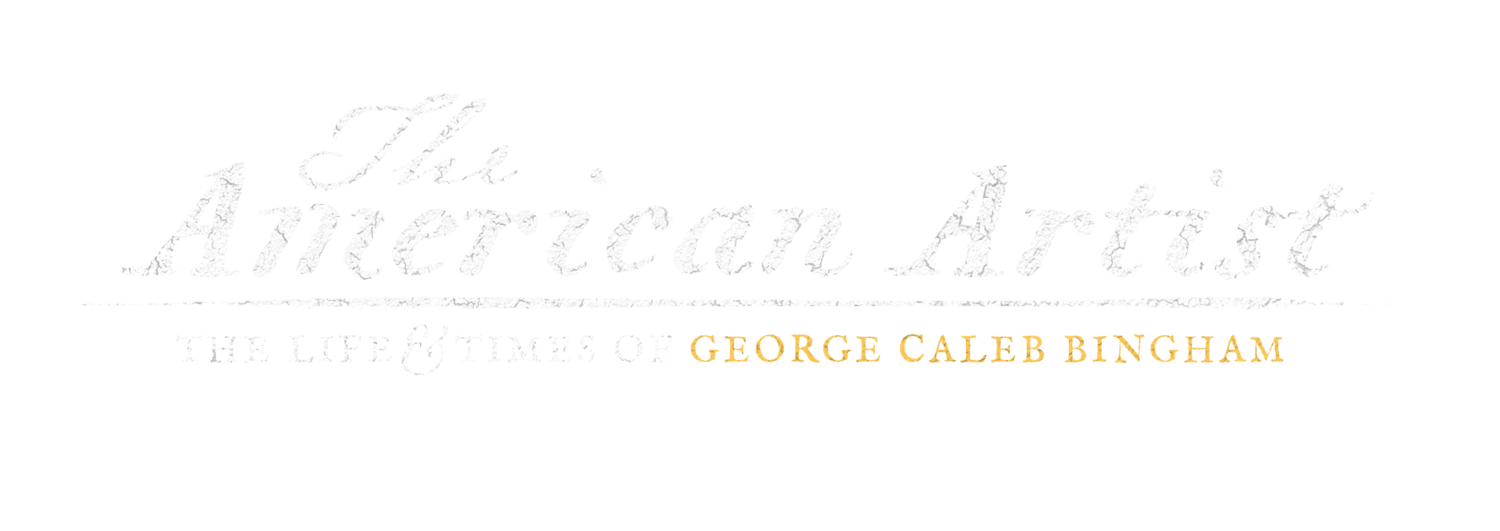Here’s something most people don’t know about George Caleb Bingham: He was one of the first American artists to “go viral.”
This achievement, as with most of the peaks in Bingham’s life and artistic career, is a confluence talent, time and place.
That is, Bingham’s incredible talent that he worked tirelessly to hone was mixed with his good fortune to be living on the edge of the Western frontier in a vibrant, maturing country, all this at a time of great social and technologic advancements. Together, all of these combined to create the perfect environment for a fine art painting to resonate with upper class and the common man and woman alike.
The Painting
The Jolly Flatboatmen, 1846 is Bingham’s most famous painting and among his more important. By all accounts it’s the painting that made Bingham’s career.
The Jolly Flatboatmen, 1846. Image courtesy The Metropolitan Museum of Art.
Its scene is a common one from 19th-century life: several men floating along a mighty river in a flatboat loaded with furs and goods. A man steers while the others goof off, dancing and playing music.
From a purely artistic standpoint it’s remarkable for its vibrant use of color. It has an energy that makes it a thrill just to look at it.
As Franklin Kelly, chief curator and deputy director at The National Gallery of Art in Washington D.C. where the painting hangs, told The New York Times in May 2015, The Jolly Flatboatmen is “a stunning, outstanding painting. It does so many things so well — the exuberance of the dancing figures and the clarity he (Bingham) got with all the other figures. It’s balanced but also so energetic.
But to really understand the painting’s importance and impact, you have to look beyond Bingham’s skillful brushwork and engaging imagery to its larger role as a significant American painting.
National Significance
Despite its western setting art commentators contend the painting is designed to speak to an Eastern audience. It’s calling them westward, an enticement to let them know the west is out there waiting for anyone who wishes to seek it.
Or as Kelly told The Times, the painting, “supported the notion that the West was there for us to take, for American expansion.
"It's part of that American experience, that 'Go West, young man.' But it's also about work and play. It's very democratic. These are working people; they're wearing their ordinary clothes — tattered — but they're having a good time. It's that notion of a democratic art in a democratic society."
Given the paintings vibrancy and subject matter, all it needed was the formats to conducive to helping it spread in fame and following.
Going Viral
Enter the popularity of mezzotint engravings and lithograph prints.
Relatively easy and cheap to produce, mezzotints and lithographs made it possible for people of all social strata to bring fine works of art into their homes, be it a brownstone on Park Avenue South in New York City or a sod home on the range in Kansas. By some estimations at one point there were more than 18,000 prints of The Jolly Flatboatmen to be found in American homes and places of business.
It would be a remarkable story of fine art meeting populist appeal if it ended there, but of course there’s even more to the story.
Once Was Lost
Bingham’s painting was commissioned for $290 to the the American Art Union, a group dedicated to promoting uniquely American art. The Union then held a raffle for the painting and it went home with the raffle winner, Benjamin van Schaick, a New York grocer.
It eventually found its way into the collection of the renowned Pell family, before making headlines in 1986 when it sold for a then record sum of $6 million and became part of the Richard and Jane Manoogian Foundation collection. Though owned by the Manoogian Foundation, the painting has hung in the National Gallery for many years.
Then in May 2015 The National Gallery made it an official part of their collection when they bought it from the Manoogian Foundation. Though The National Gallery won’t disclose how much they paid for it, it’s a safe bet they paid a lot more than Manoogian did.
Viral Again?
In an interview with NPR at the time of the purchase, Rusty Powell, director at The National Gallery, called The Jolly Flatboatmen, “the most important genre painting in American history" So it’s no wonder the painting went viral in the 1800s.
How about we make it go viral in the 21st Century? Please share this blog by using the “Share” button below.


